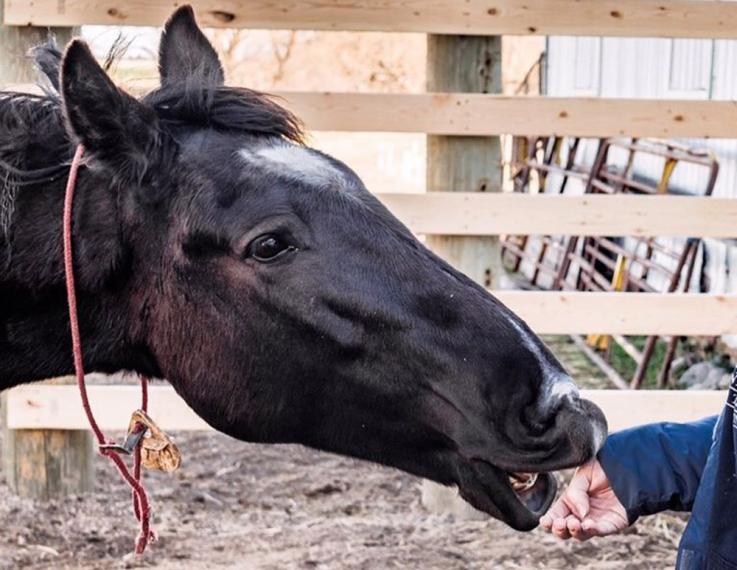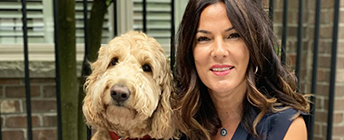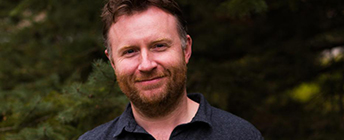Can you tame the wild?

$25 doesn’t get you a lot these days. But it got Thomasina Orr a wild mustang.
In 2019, Thomasina had settled into a job she loved, working for Pfera Inc., a tech company that provides software for horse breeders. She had graduated from the equine management major in 2016 of the Bachelor of Bio-Resource Management degree.
“I was doing less travelling and felt more stable and good in my career, so I wanted a project, one where I could see the rewards,” she says.
Her job was a perfect fit, but Thomasina could find herself falling into a rut.
It’s a feeling many new graduates can identify with. You graduate, get the job you want, and find yourself with lots of free time to fill.
To help pull herself out, she began to pursue an idea much sooner than planned: adopting a wild mustang.
“It was something that we spoke about it in the program’s equine trends and issues course at university,” says Thomasina. “I knew about them, but it wasn’t until this course that I really looked into and understood the program, why it was needed and what the outcomes were for these horses.”
Reflecting on her favourite university course, she dived back into research.
Wild Herds of Horses
Herds of wild horses and burros can be found all over the western United States. Some herds can be linked back to horses brought to the U.S. by Spaniards in the early 1500s. In recent centuries, U.S. calvary horses and ranch horses were set loose when owners could no longer look after them. Over time, these herds have grown in numbers.
The Wild Horse and Burro Act was enacted in 1971, giving the herds protection by the Bureau of Land Management (BLM), which tracks, monitors and manages them. Before that, the herds roamed unmanaged, and no laws protected them or the land they grazed.
As of March 2019, about 88,000 wild horses and burros lived on BLM-managed public land.
“The problem is that horses are not a native species to North America,” Thomasina says. “Researchers studied what would be an appropriate population, so that the ecosystem can sustain itself and the ranchers are happy with the amount of grazing land they have for their cattle.
“The ideal number is 27,000 horses. So that’s a big gap.”
When herds are in jeopardy due to limited food or water, the BLM rounds up animals and hosts adoption events. Wild horses and burros that are not successfully adopted are sent to long-term holding pastures.
Because of policies in place to protect the animals, a bill of sale is required before Canadians can bring a horse across the border into Canada.
This is where “Sale Authority” mustangs come in.
A Sale Authority mustang has been passed over at least three times at adoption events, which typically happens due to bad luck. Once this happens, these mustangs can be purchased outright for $25.
In early January 2019, a gelding shown online caught Thomasina’s eye. He had already been passed by twice. If he wasn’t adopted during the next online auction, he’d be up for grabs.
“I waited, hoping no one would scoop him up. When the auction was over, I called the BLM to find out if he had been adopted.”
Jethro, a black mustang from Cedar Mountain, Utah, was the only horse not to be adopted, and he was now eligible to come to Canada. Thomasina gave the BLM her credit card number and arranged transport.
Bringing home Jethro
It took three weeks for Jethro to travel to Canada. Because he couldn’t be trailered by anyone or unloaded for layovers, the BLM transferred him to different holding facilities throughout the United States. He travelled with other wild mustangs toward Canada, from Wyoming to Nebraska and then Illinois. There, Thomasina and her father picked up Jethro. The BLM loaded him onto Thomasina’s trailer, and they immediately began a non-stop 30-hour trip home.
“Even the most uncomplicated horses require a lot of planning when you are thinking of taking on ownership,” she says, “so bringing home a wild mustang certainly had a lot of prerequisites.”
After figuring out how to get Jethro to Canada, she needed a BLM-approved enclosure safe and sturdy enough to contain a wild horse.
“Luckily, my friend – a fellow graduate of the BBRM program – ended up moving to the area to a farm where the owner gave me the go-ahead to build what I needed to bring home a wild horse. Without that opportunity, I wouldn’t have Jethro”
When it came to training, or “gentling,” the horse, she approached the situation with no expectations and decided to do it herself. She worried that setting a strict timeline would put unhelpful pressure on both herself and Jethro.
Her years of experience working with thoroughbreds helped her feel confident in taking on the project, but she knew it wouldn’t be easy.
“Even the most difficult thoroughbreds are not wild mustangs. Domestication has ensured that,” she says. “But I did feel as though I had a good enough foundation of horse experience to go in without a plan, and I was prepared to readjust and seek out some specific training styles if I didn’t think we were making progress.”
Having no plan ended up working well for Thomasina and Jethro.
“When I did find myself stuck, we would go back to the basics and work our way up again, just in case we didn’t have a step as down pat as originally thought.”
Thomasina also challenged herself to reflect on why Jethro was behaving or reacting in a certain way. She worked to understand how he was interpreting situations and reasons for his behaviour. Thomasina had to learn how to mitigate his fear responses.
“On one hand he is very brave, confident and secure thanks to his big ego,” she says, “but he is understandably also very invested in self-preservation, and it never seems to be the situations you would expect.”
Taming the Wild
Thomasina let Jethro show her his boundaries and approached training at his speed. It was slow and uncertain at times, as she questioned whether he was learning.
“If he came over and let me brush him, unrestrained, free to leave at any time, I knew he was allowing it because he was okay with it. I repeated that approach again and again with each task,” she says.
Ensuring consistency in his training was another challenge.
“I had to force myself to stay consistent, regardless of what was going on in the rest of my life. I have struggled with depression for most of my life, meaning that sometimes things were not good, and now I had a horse with little to no value, waiting on me to make his life purposeful.”
A lot of days, Thomasina just showed up. She spent hours with Jethro doing no training at all, sometimes reading a book while he ate hay.
“It felt like a failure at the time, all those ‘empty’ hours, but I think it kept the trust bar slowly inching along in the right direction.”
Slowly, they made progress together.
The small interactions that most horse owners take for granted were some of the most rewarding for Thomasina.
“I don’t think I’ve ever had another time where I’ve been so excited to say, ‘I brushed a horse’ or ‘He let me touch his face.’”
Today Jethro is “green broke,” meaning he can walk, trot and canter under saddle, travel through creeks, climb banks and take on obstacles with ease.
Their most rewarding accomplishment together was Thomasina’s first ride at her grandparents’ farm. Jethro lives only a few roads away but getting to the farm requires travel on a busy highway under saddle.
“If I wanted to get there, I was going to have to ride him and be okay with transport trucks flying past us.”
Last summer they traversed the route for the first time, and Thomasina rode Jethro over the rolling fields of the 165-acre cattle farm.
“I couldn’t stop thinking about how I was actually on the wild mustang that I had wanted for years, gentled myself, and was now riding on the family farm.”
This article was originally published in the LIBRANNI 2021 / Vol. 3. All photos in the print publication were taken by Savannah Petrachenko.
If you’re interested in learning more about Thomasina and Jethro, you can follow them on Instagram.
 |
Read more:Removing the legacy lens to see innovation
|
 |
Read more:Q&A with a social enterprise development coordinator |